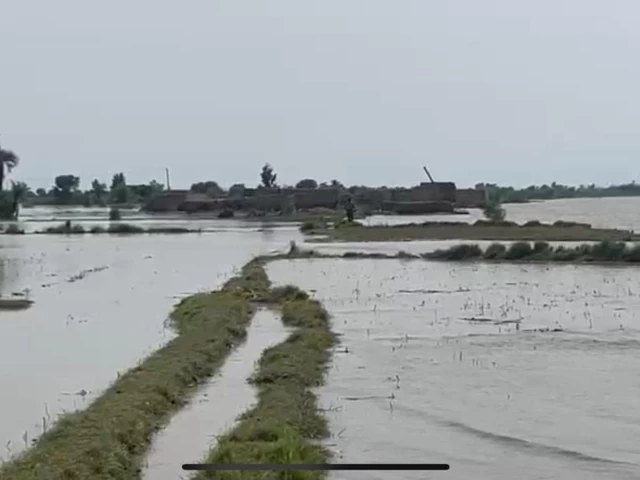The flooding in Punjab is limited to the muddy marshy strips of land that sit next to the rivers, also known more technically, as riverine or katcha areas.
“In the katcha areas, every house has its own boat, every year the same type of flood situation occurs,” said a local resident. So far no damage has been reported in settled areas.
The Kacha area in Pakistan refers to the riverine settlements established along the River Indus. These settlements span all the way from Kot Mithan in south Punjab to the coastal areas in Thatta in Sindh. These areas, year after year, are faced with medium to high-level flooding. This year, they are drowning yet again.
Katcha areas in Layyah, Kot Addu, Taunsa Sharif, Dera Ghazi Khan and Rajanpur are among the worst affected. Thousands of people residing on riverine settlements have been evacuated to safer areas. According to the Flood Control Room, the floods have devastated the riverine settlements and the flood continues in Rajanpur.
The flow of water at Kot Mithan point in the River Indus has reached 490,000 cusecs. Water has entered settlements on the river banks and remains there, with people being forced to evacuate in boats.
In the areas of Dera Ghazi Khan and Taunsa Sharif, there is medium-level flooding and the floodwater has penetrated dozens of settlements, like Ghat and Darahma, along the River Indus.
However, water level does seem to be on the decline in areas like Taunsa Sharif, with 500,000 cusecs now down to 360,000 cusecs. Rescue missions continue to evacuate people and many residents have migrated themselves.
Taunsa Sharif particularly suffers, with our correspondents reporting that despite the fact that River Indus’ water level has decreased, link roads still remain submerged. Locals report a sharp decline in living standards, as no arrangements have been made for drainage in the affected areas. Residents of Taunsa have complained of a severe stench that has engulfed the flood-hit areas, and expressed fear of diseases as humidity and suffocation engulfs the district.
In Muzzaffargarh, mosques are making announcements on behalf of Rescue 1122, warning people of possible flooding in the River Chenab. Evacuations of low-lying areas near the River Chenab are underway.
20 union councils of Tehsil Karor Lal Esan, Tehsil Layyah and Kot Sultan in Layyah are flooded. Hundreds of acres of crops are reportedly destroyed, with roads, schools, mosques and houses all swept away by the river. Layyah faces a similar struggle of shortages, as link roads are drowning in floodwater. “Houses have been demolished, people are dying of hunger, no one has helped,” said an affected resident of Layyah.
The River Sutlej is experiencing a continuous increase in water-levels, causing medium-level floods of riverside settlements. Water is reported to have flooded dozens of settlements like Mauza Mero Baloch, Mauza Jateera, Mauza Noon and Mauza Saldira.
Flood affectees of Vehari have stated that standing crops of thousands of acres have been destroyed, and that fodder for animals is finished. The affectees are in fear of a high-level flood due to increasing water-levels, while arrangements by administration seem to be insufficient.
There is high level flooding at the Head Ganda, Bahawalpur. The water level is 21.10 feet and the outflow is 133,770 cusecs. Medium-level flooding has been observed at Head Sulemanki, where water inflow is 94,143 cusecs.
The Flood Forecasting Division (FFD) and Federal Flood Commission (FFC) have warned that the Rivers Chenab and Indus are likely to reach high flood levels within 24 hours, while the Sutlej at Ganda Singh Wala will continue at high levels for several days, depending on reservoir releases from India.
India, in accordance with the Indus Water Treaty, has alerted Pakistan regarding a potential high-level flood in the Tawi River near Jammu on Sunday. According to the FFD, medium-level flooding is to be expected in Guddu, Sukkur and Sulemanki.

